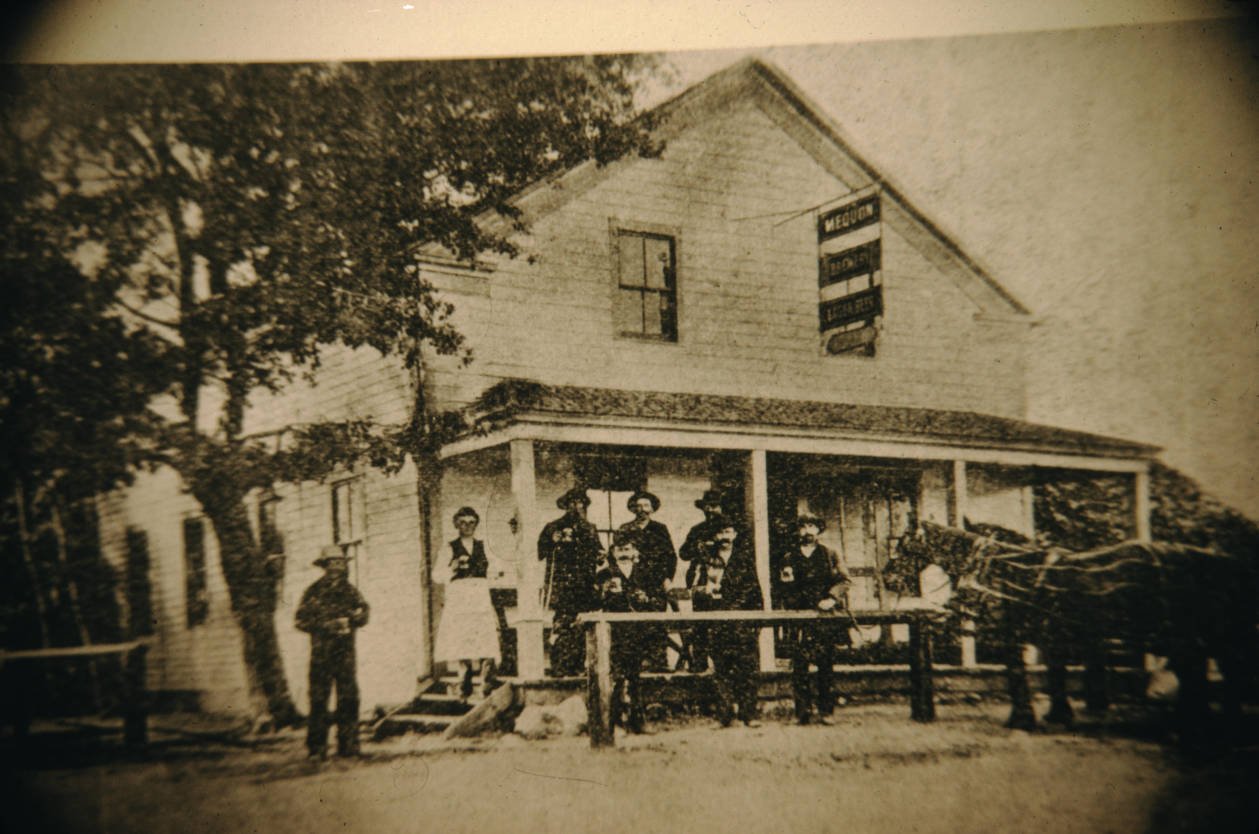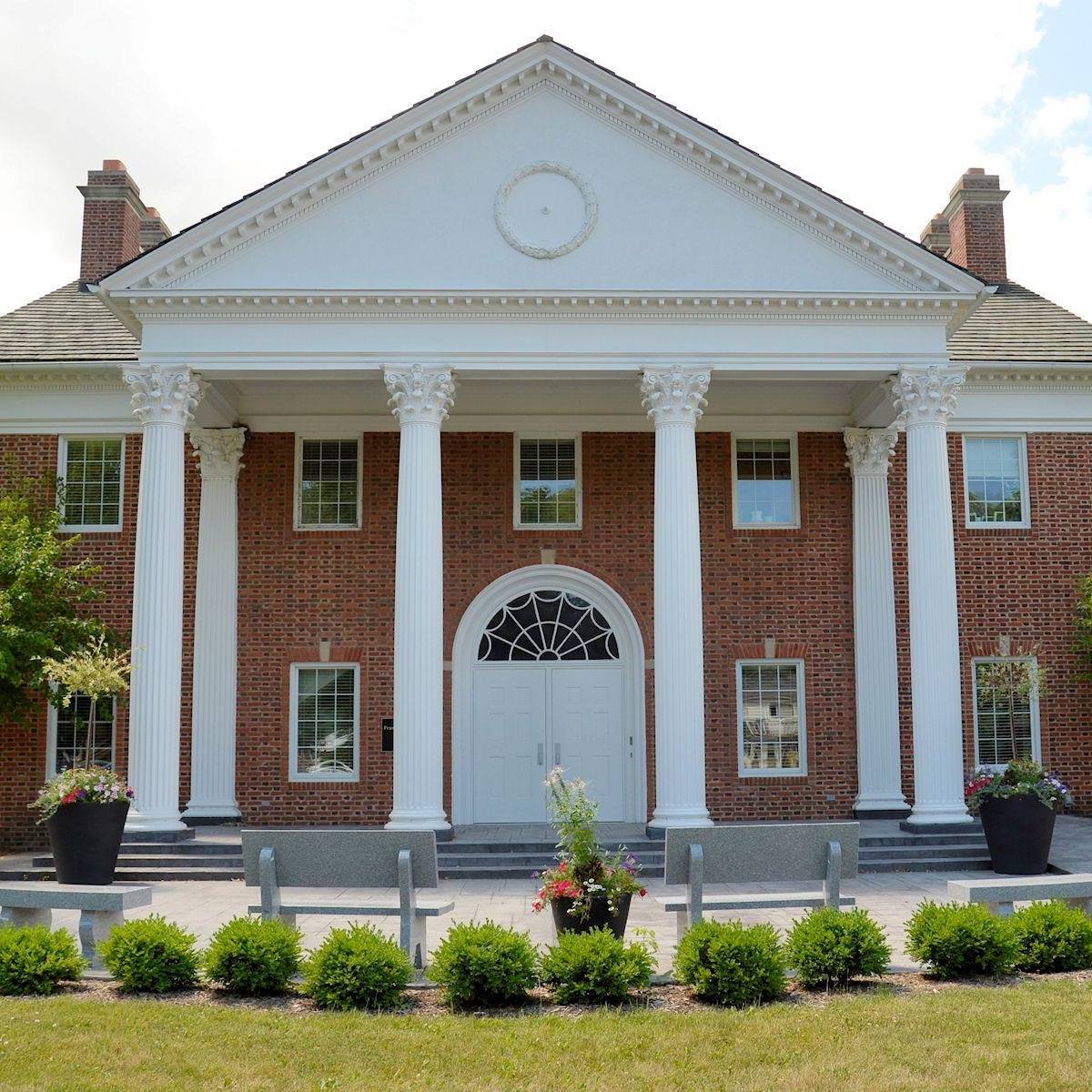The Historical Meanings Behind Mequon’s Names
The first saloon in Mequon at Mequon and Cedarburg Road. Photo via Frank L. Weyenberg Library.
Mequon, Wisconsin, weaves together a tapestry of Native American heritage, German Lutheran settlement, pioneer families and natural geography. From the city's name itself—derived from the Ojibwe word meaning "ladle" for the Milwaukee River's distinctive bend—to modern subdivisions that honor agricultural roots, Mequon names tell part of the story of this community that balanced historical preservation with growth.
Native American heritage and early settlement
Mequon's story begins with its very name, which honors the original inhabitants who recognized the Milwaukee River's distinctive "ladle" shape. The Ojibwe word "Emikwaan" or "Miguan," meaning ladle, perfectly describes how the river bends through the area. Alternative interpretations suggest it comes from the Menominee word "Mēkon," meaning feather, but both reflect the deep Native American heritage.
The Menominee, Potawatomi, and Sauk tribes called this area home, with the Milwaukee River serving as a territorial boundary between the Potawatomi (west) and Menominee (east). The Potawatomi had a village in present-day Thiensville on Pigeon Creek, north of where Freistadt Road runs today.
The first European settlers arrived in 1836 when Isaac Bigelow and Daniel Strickland established permanent homes. Pioneer Road today honors these early settlers. John Weston, who became the first postmaster in 1837, settled near present-day Thiensville, while Isham Day built one of the oldest surviving buildings in 1839—now home to the Mequon-Thiensville Historical Society's Postal Museum.
Freistadt: The "Free City"
Credit: The historical marker database
The most compelling street name story in Mequon centers on Freistadt Road, which leads to Wisconsin's oldest Lutheran settlement. In October 1839, twenty German families from Pomerania, Prussia, arrived seeking religious freedom. They were Old Lutherans fleeing persecution under Prussian King Frederick William III's attempts to merge Lutheran and Reformed churches.
These families established "Freistadt," meaning "Free City" in German, and built Wisconsin's first Lutheran church in 1840—Trinity Lutheran Church, which still stands today. The Freistadt community preserved its Pomeranian German culture through traditional music, folk dance, and the annual Pommerntag celebration. Streets throughout this area reflect the deep German Lutheran heritage that began with these religious refugees.
Thien legacy: Immigrant to village namesake
Joachim Heinrich Thien arrived from Oldenburg, Prussia, in 1842 and left such a mark that an entire village bears his name. Thien purchased John Weston's holdings and transformed the area by building a dam, canal, sawmill, and store on the Milwaukee River. He hosted the first Town of Mequon meeting in 1846 and established the volunteer fire department in 1857, serving as its first captain.
Today, Thiensville remains completely surrounded by Mequon, creating what locals call "Mequon's donut hole"—a unique geographic situation reflected in the dual city name of Mequon-Thiensville for the school district and historical society.
Water shapes the land and the names
Mequon's street names consistently honor the waterways that shaped settlement patterns and provided economic opportunities. The Milwaukee River, with its distinctive "ladle" shape, determined where early mills were built and how communities developed. Pigeon Creek, which flows through eastern Mequon, recalls the Native American village that once thrived along its banks.
Donges Bay Road leads to one of the area's most significant natural features—a 23-acre nature preserve featuring steep ravines, Lake Michigan beach frontage, and rare plant species. This area gained national attention as the site of the first successful bald eagle nesting in southeastern Wisconsin in over 100 years.
Little Menomonee Creek and River wind through western Mequon, while Cedar Creek connects to the broader network of waterways that made this area attractive to settlers. These geographic features didn't just influence where people settled—they determined the very street patterns that exist today.
Katherine Kearney Carpenter Park
Katherine Kearney Carpenter Park received its name in honor of Katherine K. Carpenter, who generously donated the 35-acre parcel to the City of Mequon in 1967. The gift came with the stipulation that the land be used solely for public park purposes—and that it remain accessible to children and pets without restriction.
Today, the park serves as a major dog-walking area with wooded trails, a creek, and ample open areas, continuing her vision of inclusive, public enjoyment . Her enduring legacy is a scenic, welcoming greenspace that truly lives up to the intent of her gift.
Frank L. Weyenberg Library
The Frank L. Weyenberg Library serves both Mequon and Thiensville
Frank L. Weyenberg (1882–1976) was a prominent Mequon resident, industrialist, and philanthropist who made his fortune in the shoe manufacturing business. He was born in 1882, the year his father and uncle opened a shoe shop. Frank had little more than elementary school education. He first learned the shoemaker's trade and then became the company's sales representative.
Frank took charge of the Milwaukee company and, in 1906, at the age of 24, became the first president of the Weyenberg Shoe Manufacturing Company. He lived on the Wey Acres estate with a small windmill, a reminder of his Dutch heritage. The Wey Acres subdivision in Mequon still bears his name today.
After World War II, the company focused exclusively on the production of luxury men's shoes. In 1964, Thomas Florsheim succeeded Frank as managing director. In 1990, the company's name was changed to Weyco Group Incorporated, which specialized in men’s footwear. This marked the permanent disappearance of the Weyenberg name from the shoe industry. The name Weyco still serves as a somewhat hidden reminder of the original Weyenberg Company.
In 1971, his wife, Helen Weyenberg, donated the funds (about $500,000) to build the library in his memory. The two‑story, Colonial Revival structure opened that year at 11345 N. Cedarburg Road. The contribution led the community to honor him as “Mequon Man of the Year” in 1970. Today, the Frank L. Weyenberg Library serves both Mequon and Thiensville, offering books, digital resources, community programs, genealogy services, maker spaces, and event spaces like the Tolzman Community Room.
Transportation routes become corridors
Green Bay Road carries the weight of 12,000 years of history, originally serving as a Native American migration route. Later, it became a mail route between Fort Dearborn (Chicago) and Fort Howard (Green Bay), with the first stagecoach service beginning in 1836. Congress designated it an official post road in 1832, making it one of the region's most historically significant transportation corridors.
Port Washington Road connected Mequon to the county seat, carrying 11,900 vehicles per day in some sections today. Mequon Road (Highway 167) serves as the major east-west artery, while Highland Road recently received a new Interstate 43 interchange, reflecting the community's ongoing evolution.
The Ozaukee Interurban Trail preserves the route of the former Milwaukee-to-Sheboygan passenger rail line that operated from 1907 to 1948, now serving recreational users while maintaining the historical transportation connection.
From farms to subdivisions
Mequon's transition from agricultural community to suburb is reflected in its neighborhood naming patterns. Early developments like Beechwood Farms honored the agricultural heritage, while The Pines (established 2000) and Concord Creek (established 2010) reflect environmental consciousness and natural features.
Each subdivision demonstrates distinct themes: Stonefields references geological materials, Gazebo Hills combines architectural and topographical elements, and Vintage Estates suggests historical prestige. These names show how developers marketed to buyers seeking connections to both nature and heritage.
Swan Road provides access to the Mequon Nature Preserve and Swan Road Prairie, while maintaining the rural character that attracted suburban residents. The 83-lot Swan Ridge Farms development at County Line Road demonstrates how modern development continues to reference agricultural roots.
Educational and cultural landmarks
Concordia University Wisconsin and Wisconsin Lutheran Seminary continue the religious and educational tradition established by the original German Lutheran settlers. These institutions maintain the theological heritage that began with Trinity Lutheran Church in 1840, creating a continuous thread from immigration to modern education.
Homestead High School's name reflects the agricultural homesteading heritage that dominated the area for over a century. The school serves as a reminder of the farming families who shaped the community's character and values.
Stories in every street sign
Mequon's street names reveal a community that successfully balanced historical preservation with modern development. From the Native American word that became the city's name to the German Lutheran settlement that established Wisconsin's first Lutheran church, from pioneer families who cleared the forests to modern developers who honor agricultural heritage, every street name contributes to an ongoing story of cultural preservation and community identity. These names don't just help residents navigate their city—they connect them to the rich tapestry of cultures, faiths, and dreams that built this unique Wisconsin community.






The City of Mequon welcomes families, neighbors and visitors to its annual Winter Wonderland Festival on Sunday, December 7, from 3:30 p.m. to 5:30 p.m., in front of City Hall.